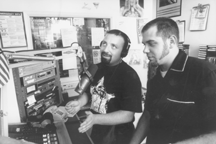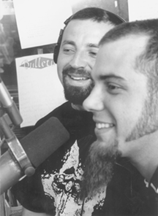

[ Music Index | Metro Santa Cruz | MetroActive Central | Archives ]
A Rock Revolución
G-Force Dr. G, seen here with "El Chivo," oversees weekly radio show "Mi Vecindad" ("My Neighborhood") on KZSC, where he has become Latino program director. More recently, Dr. G (aka Gerardo Sandoval) has become a major player in the Spanish-language music industry.
A new wave of Spanish-language musical insurgents rocks America's barrios and ballrooms with the sounds of social change
By Judi Blackwell
A charismatic figure with plentiful earrings and squared-off sideburns sprouting up from his blunt-cut dark hair, Gerardo Sandoval can't stay seated. Slipping in Rey Azucar, the latest CD by Argentina's Los Fabulosos Cadillacs, he jumps out of his chair and starts skanking to the beats of "Mal Bicho," an upbeat, heavily horn-influenced track.
Possessing a Jekyll/Hydelike personality, the normally soft-spoken 24-year-old East L.A. native transforms himself into the tumultuous Dr. G when he sits down behind the mic for his weekly radio show on KZSC, Mi Vecindad ("My Neighborhood"), where he has become Latino program director and, more recently, a major player in the Spanish-language music industry.
In between questions, Dr. G answers the phone, which has been ringing nonstop with callers. "Hello. May I help you?" he answers in an exaggerated English accent. The caller on the other line hangs up and Dr. G starts laughing. "They don't know what to do when I answer in English," he says. "They usually hang up."
The music blaring out from behind the DJ booth resembles what one might hear on alternative stations KOME or Live 105--except the bands are from Mexico and Latin America, the audience is 99 percent Latino and the lyrics are in Spanish. It's not just rock--it's rock en español.
The phone rings again as Virgilio González, a faithful fan, walks into the room. "Immigration," Dr. G answers with a mischievous grin.
Dr. G cues up the latest number by Puerto Rican rocker Robi Rosa and González crinkles his nose, exclaiming, "He sucks. Maná sucks, too. They don't use their imaginations. They don't want to make people think. They just want people to listen. Caifanes, Maldita Vecindad--they are my heroes. They talk about our people, the poverty, the relationship between us and the USA."
Indeed, with immigration bashing at an all-time high and laws like Proposition 187 fueling controversy and hatred, bands like Maldita Vecindad (whose full name, Maldita Vecindad y los Hijos del Quinto Patio, translates roughly as Damned Neighborhood and the Sons of the Fifth Tenement) have become voices for thousands of disaffected fans.
"There is a need for Latino heroes in our youth," Dr. G says. "This is a great way to help the community--through our music."
Speaking La Lengua
The music featured on Mi Vecindad is only the latest in an outpouring of Spanish-language punk, rock, ska, gothic, metal, death-rock, alternative, pop and rap bands across the border into the States. Every week, hundreds of fans gather at places like the Catalyst and the Vet's Hall in downtown Santa Cruz, Alberto's in Mountain View, Phoenix in downtown San Jose, La Rockola in Berkeley and various rented halls throughout the greater Bay Area to soak up the new sound delivered by both visiting bands and the new homegrown crop of rockeros. But unlike Los Angeles, where there are dozens of local bands and more than 30 clubs featuring live rock en español, Northern California lacks many venues willing to promote local groups. "It's getting better. I see more people getting involved," says Hector Marquez, a.k.a. El Chivo, Dr. G's protégé on Mi Vecindad. "There's potential."
Although the crowds are beginning to swell, rock en español in this area is still poised between import status and breakout acceptance. "We draw stadium-sized crowds at home," says Lino Nava, the boisterous guitar player for La Lupita, an eclectic outfit from Mexico City that recently played in front of 400 people at the Vet's Hall, "but in the United States, we must play small venues to get our name out. It's unfortunate that people in America are not as open to music in other languages."
The bands, from Mexico and Central and South America, experiment with beats and genres familiar to rock fans everywhere, from heavy metal and punk to ska and synth-rock, but their audiences in the United States are still almost entirely composed of Spanish speakers, primarily first-generation immigrants. That kind of language barrier forestalls any notions of crossover success--just yet.
The best of the rock en español bands often adapt the rebellious, subversive power of rock & roll to political and social messages. "I listen to all kinds of music--from hard stuff like Faith No More and Nine Inch Nails to acid jazz and rap and disco," San Jose rockero Roman Bolanos says. "But this music speaks to me and my people. It's part of my culture."
This application of a universal style of antiauthoritarianism to specific, localized concerns is most obvious in the bands from Mexico, where the government, in the wake of the 1968 student protests, cracked down on youth culture for years.
Dinero Talks
But money changes everything, and major labels are taking notice of rock en español's burgeoning U.S. popularity. Since the introduction of MTV Latino, clubs and promoters are vying for bands, record labels are opening Latino divisions and Spanish-language radio stations are airing rock en español programs. Everyone from Sony Records to headbanger Rudy Sarzo of Whitesnake, who started his own Latin rock label, is tapping into the market.
Corporate sponsors also are beginning to jump on the bandwagon. "Budweiser and the big companies are pulling funds out of banda and mariachi and putting them toward [rock en español]," says Maria Garcia, a DJ for KNTA (1430 AM), downtown San Jose's Spanish-language radio station.
Laffite Benitez, West Coast promoter for BMG, one of the record companies most actively promoting Latino music, says that Chicanos (second- and third-generation Latinos born in the U.S.) and even non-Latinos are now starting to pay attention.
"Most of the airplay these bands get is from college stations, and college kids tend to be more open-minded," Benitez says. "Non-Spanish speakers are getting into the music without the bands having to change their style or language. They don't know what they're saying, but they understand the music."
Benitez doesn't think that commercial pressures will inevitably force bands from Mexico and Central and Latin America to sacrifice their linguistic roots to catch on in the U.S. market: "They will never become bilingual."
The situation for new rock en español bands born in the immigrant and Chicano communities of the United States, however, is more complicated. There is a future, Benitez thinks, for Chicano bilingual bands with ties to both their Latino heritage and their American neighborhoods. In Los Angeles, he says, there are dozens of bands singing in both languages.
Elena Rodrigo of Aztlan Records--a young, independent San Francisco label specializing in U.S. rock en español bands--is even more confident that commercial demands won't denature the sound. "I really believe rock en español doesn't need to be bilingual to grow. You can't understand the lyrics in most grunge and punk, anyway. The music catches you first, before the lyrics."
Dr. G's Spot
Although Dr. G graduated more than a year ago with a degree in psychobiology from UCSC, he decided to stay on at KZSC to help further the rock en español movement. He also has joined forces with Aztlan Records in order to get more involved in the industry.
"College radio stations are the only ones playing rock en español," he says, pointing up a paradox about the diverse Spanish-language music market. "Most other Spanish-language programs stick to salsa, merengue, banda and pop bands like Maná."
According to Dr. G, even in Mexico and Latin America the government leads a campaign against rock en español because the bands are considered too rebellious.
While flipping through his massive collection of CDs, Dr. G briefly explains the origins of Spanish-language rock in Mexico. "The music has been around since rock started in the USA, but it's just now gaining momentum here."
Originally, most of Mexico's bands were copycat versions of American sensations--like the Beatles, Elvis, Little Richard, the Rolling Stones--and they performed both covers and originals in English. After the student protests of 1968 and the crackdown that followed a Woodstock-like concert in Avándaro in 1971, Mexico's musical counterculture was driven underground.
What emerged from this censored periphery almost a decade later were bands--like El Tri and Ritmo Peligroso--that no longer wanted to emulate their American counterparts. Instead, they emphasized their Mexican identity. Dozens of bands followed suit, and by the early '90s Maldita Vecindad, Caifanes, Fobia, La Castañeda, Café Tacuba, Maná, La Lupita and many others were heading up what was beginning to look like a crusade.
Singing in Spanish about real-world issues, it's these bands that reach out to fans in the same visceral way that the best rockers always have. As Anita Gonzalez, an avid listener of Mi Vecindad, says, "I love Nirvana and Pearl Jam. But it's bands like Maldita Vecindad and Caifanes that I connect with. These are real Mexicans singing in Spanish about my people and my culture."
This page was designed and created by the Boulevards team.

Robert Scheer
From the July 11-17, 1996 issue of Metro Santa Cruz
Copyright © 1996 Metro Publishing and Virtual Valley, Inc.